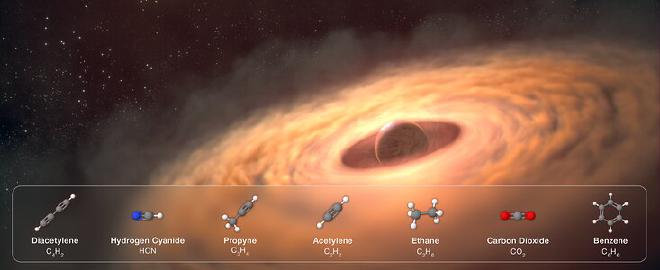

Our Solar System contains eight major planets, and more than 400 known moons orbiting six of these planets. Where did they all come from? There are multiple formation mechanisms. The case for large moons, like the four Galilean satellites around Jupiter, is that they condensed out of a dust and gas disc encircling the planet when it formed. But that would have happened over 4 billion years ago, and there is scant forensic evidence today.
The young star the planet orbits is only 2 million years old and still accreting circumstellar material. However, the circumplanetary disc discovered by Webb is not part of the larger accretion disc around the central star. The two objects are 74 billion kilometres apart.
This discovery fosters a better understanding of planet and moon formation, say researchers. Webb’s data is invaluable for making comparisons to our Solar System’s birth over 4 billion years ago.
Dissecting starlight #
Infrared observations of CT Cha b were made with Webb’s MIRI (Mid-Infrared Instrument) using its medium resolution spectrograph. An initial look into Webb’s archival data revealed signs of molecules within the circumplanetary disc, which motivated a deeper dive into the data. Because the planet’s faint signal is buried in the glare of the host star, the researchers had to disentangle the light of the star from the planet using high-contrast methods.
Ultimately, the team discovered seven carbon-bearing molecules within the planet’s disc, including acetylene (C2H2) and benzene (C6H6). This carbon-rich chemistry is in stark contrast to the chemistry seen in the disc around the host star, where the researchers found water but no carbon. The difference between the two discs offers evidence for their rapid chemical evolution over only 2 million years.
Genesis of moons #
A circumplanetary disc of debris has long been hypothesized as the birthplace of Jupiter’s four major moons. These Galilean satellites must have condensed out of such a flattened disc billions of years ago, as evident in their co-planar orbits about Jupiter. The two outermost Galilean moons, Ganymede and Callisto, are 50% water ice. But they presumably have rocky cores, perhaps made of carbon or silicon.
We have to wait… #
In the coming year, the team will use Webb to perform a comprehensive survey of similar objects to better understand the diversity of physical and chemical properties in the discs around young planets. “The insights could be useful -stated ESA-, especially as our Jupiter Icy Moons Explorer (Juice) makes its way to Jupiter, and as we prepare a future mission to orbit and land on Saturn’s moon Enceladus”.
Citation #
-
The paper A Carbon-rich Disk Surrounding a Planetary-mass Companion was published in The Astrophysical Journal Letters. Authors: Gabriele Cugno & Sierra L. Grant.
-
The article Webb studies moon-forming disc around massive planet was published in ESA Webb, NASA and ESA’s websites
Contact [Notaspampeanas](mailto: notaspampeanas@gmail.com)

